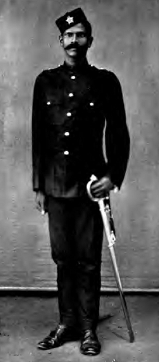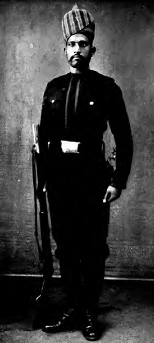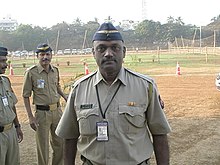Bombay City Police
The colonial Bombay City Police emerged as such from the all-India legal reforms of 1793-1809, as the successor to the paramilitary Bhandari militia , on the island bearing this name immediately off the western coast of India . During colonial rule , the European police superiors also had far-reaching criminal judicial powers. The modern successor organization has been called Mumbai Police since the city was renamed .
1790-1809
Following the English model, a Commission of Peace with justices of the peace was set up in 1793 , whereby the Indian judiciary was placed on a reasonably modern basis by the Cornwallis Code . As a result, the Bhandari militia was disbanded. The post of chief of police, with reduced powers, was renamed Superintendent of Police . The first incumbent until 1808 was Simon Halliday . The areas outside the city walls were divided into 14 districts in 1800, whose stations ( chauki ) were each commanded by two gendarmes and to which a total of 130, not overly obedient, auxiliary policemen ( peon ) were subordinate. Market supervision and route control passed from the police to the community in 1809, but pawnbrokers and shroffs (indigenous bankers) had to get a license, which was supposed to curb stealing .
1809-1855
Due to a variety of complaints, they were forced to curtail the executive power of the Superintendent of Police in 1811 . Police magistrates , each with their own staff, have now been set up in three districts to try minor crimes. The Deputy of Police and High Constable was now responsible for the actual police , who also took on port supervision. This arrangement remained unchanged until 1856.
Personal union
The chief of police at that time were initially also magistrates . In the fast-track procedure, which was not even recorded, prison sentences of several years, banishment, fines or flogging could be imposed. He also sat (until 1811) in the Court of Petty Sessions, whose three judges always made short work of Mondays from 10 a.m. The pillory was abolished in 1844. The chief of police was ex officio a member of the Board of Conservancy (1845-58), then one of the three Municipal Commissioners who controlled the city administration until these positions were filled full-time after 1865, and until 1888 he was still the chief of the fire brigade, its commanders were also selected from among the European members of the police force.
Port and water police
Although police were already available to control the port in the past, a special water police force, the Harbor and Dock Police (1885: 101 men, plus 50 in Prince's Dock ), later Police for the Port of Bombay, was established as a separate unit to control the port and entry and exit controls. In the docks they had their own 84-man (1865) force, paid for by the Navy.
1856-1916
The previous deputy chief of police Charles Forjett achieved through rigorous action on the one hand that the Sepoy uprising of 1857/8 did not encroach on Bombay, and on the other hand that street and gang robberies were almost completely suppressed after 1859. This was at a time when Bombay was beginning to grow explosively. The number of simple property crimes remained high until the end of the century.
With the introduction of a uniform criminal procedural law and penal code (1874), there was also better control of arbitrariness. On the other hand, the police's right to issue security ordinances has been expanded. The police courts were abolished in 1877. The number of petty criminals brought to justice rose from 21,500 in 1874 to 28,000 six years later. In 1908, charges were brought 41,000 times.
In the following years the health police (1884-88) and passport issuance for the increasingly numerous Mecca pilgrims were added as new tasks. In 1893-4 the number of permanent positions was increased to 2,111. The ban on the sale of opium led to an increase in alcohol-related violent crime. Regulatory police tasks, which are still an important area of responsibility today, such as B. Fire police, the licensing of alcohol sellers and hawkers, were added more and more.
The devastating famines (1896, 1899–1902) and the plague epidemics (1896/7 and 1902) led to an increase in property crimes. Stakes were erected in the harbor, on which starving people could be whipped immediately. At the turn of the century almost Rs. 793,000 were spent on the police, and from 1907 the provincial government also took over the city's share of the costs. Soon afterwards, numerous police stations were renovated or improved, and the Indian constables were increasingly taught reading, writing and English.
The urban area of Bombay was administratively divided into nine police divisions in 1899 , plus the criminal police and a police reserve. Each division was divided into several sections, each with a police station, which was usually headed by a white inspector. Since 1911 there was a Police Gazette, a circular letter (with profiles, etc.) issued three times a day to all police stations.
The Bombay City Police Act (IV of 1902) placed the entire force under the control of the Commissioner. The law gave the police officers far-reaching powers of control, especially over the “criminal castes” and the growing industrial proletariat, which led to increased arbitrariness and corruption even in the lower ranks. A separate Motor Vehicle Department was founded in 1909.
The Bombay City Police, like any police unit, was and is an organ of state surveillance and repression. Suppression became all the more important as strikes, the Home Rule movement (1915), the riots of 1929, and then the campaign of civil disobedience took off . A special law made it a criminal offense to incite police officers. The constitutional reforms of 1919 and 1935 did not give Indians much greater say and control, but that did not mean that loyal Indians could not rise to the middle officer ranks.
Equipment, personnel, costs
The uniforms of the gendarmes consisted of a yellow turban or cap, dark blue uniform skirt and shorts, as well as a black belt. Later on, black low shoes and stockings were used, and men and sergeants also used dark headgear reminiscent of berets. The armament consisted of batons or sabers, and European officers carried revolvers. There was a small mounted division.
Ordinary sergeants received a meager monthly salary of Rs 10 in 1885, when less than a quarter of the troops could read and write, which led to difficulties in recruiting. About a tenth of the police officers were housed in their own miserable dormitories ( chal ), the rest received a rent subsidy (1 row ). In 1907 the local constables went on strike, and the government increased the pay for the three lowest ranks to Rs 12-15.
In 1865 the team was increased to 1,456, under six superintendents and 22 inspectors. Of these, 1239 were normal police officers, 116 guards at official buildings and 101 men with the port police, up to 300 men were posted to the service as railway police in the following years, which led to acute understaffing. By 1915, the strength of the troop had been increased to a good 3,000. The police have had their own hospital since 1866, which has been in Nagada since the completion of the new building in 1904.
Personnel costs were Rs 475,297 in 1885, and Rs 505,000 three years later when 100 more men were on duty. After the 1908 salary increase, expenses rose to Rs 975,000 annually, and Rs 1.33 million by 1915.
Criminal police
A separate criminal investigation department ( Detective Branch generally called CID ), which also used plainclothes police, was set up beginning in 1872. From 1894 anthropometric measurements according to the Bertillion system were introduced, and fingerprints began four years later . After Tilak's conviction (1908), the CID, as a state security department, was also responsible for the control of potential political criminals; the department was placed under its own Deputy Commissioner . Theater censorship and the enforcement of the Press Act; d. H. Confiscation of "incendiary" printed matter was added as a task.
Mumbai Police
Nowadays the city police are called Mumbai Police (मुंबई पोलिस), they are also known as Brihanmumbai Police . The first Indian commissioner was JS Bharucha in 1947. Like all such organizations, the police have survived unaffected by regime changes, both in their structure and as an instrument of repression. As elsewhere, they are often "blind in the right eye". Corruption, even in the lower ranks, remains, as everywhere in India, widespread. Due to the chronic overload and corruption of the Indian judiciary, an effective legal protection against arbitrariness was and is not guaranteed.
After independence, beige uniforms were introduced, sergeants wear dark blue boats with a yellow ribbon, officers wear caps. Mumbai has remained one of the economically liveliest cities in India. This is one of the reasons why organized crime spread increasingly from the 1960s onwards. Several investigative commissions have tried to uncover the links between the police and the mafia. From 2005 the modernization of the equipment began. Almost half of the 3,000 vehicles in use are motorcycles.
Modern organization
Nowadays the police are subordinate to the interior minister of the state of Maharashtra , their regional responsibility extends to the city and the suburban district, where over 13.5 million people live on an area of 603 km². There are 89 police stations in twelve zones (plus the port), the port police have 10-15 boats on duty. 36 new speedboats will soon be put into service. The police, whose administrative structures still follow the colonial pattern, now have 40,914 men, 4,763 of whom are officers (sub-inspector and higher ranks.)
In addition to the central departments for administration, human resources and prevention, the traffic police exist as a semi-autonomous separate unit that divides the city area into 25 districts for their purposes. Special units exist:
- Kripo ( Crime Branch ) with its own departments for economic offenses and extortion ( anti-extortion cell )
- the Encounter Squad, with almost 1,500 men, is responsible for organized crime (officially since 1997)
- Teenagers
- Narcotics investigation ( Anti-Narcotics Cell , independent since 1989)
- Missing
-
Special branch with additional tasks like
- Terrorist manhunt
- Protection services ( Protection & Security )
- Riot police with three companies, Riot Control Police and Local Armed Police, the latter barracked.
- Control and security of airports and ports

The methods of the Encounter Squad , unofficially created in the 1980s, are questionable from a constitutional point of view and are criticized by human rights organizations. The number of suspected gangsters who were “shot while trying to escape” in the 1990s is over 100. In 2005, a special tourist squad was created, which is essentially limited to monitoring the beaches. Since July 2009 there has been a special unit specializing in computer crime.
Armament
In addition to the bamboo batons ( lathi ) commonly used throughout India for otherwise unarmed patrol officers , firearms and armored vehicles are also used. War weapons are used especially in the special units, some of them still rifles from the First World War such as Lee-Enfield SMLE Mk III , the Indian model Ishapore 2A1 (from 1963), on submachine guns 7.62 MM 1A1, Assault Rifle 7.62 mm, 38 MM Multi Shot Riot Gun, INSAS 5.56 mm and 247 pieces AK-47 , FN-FAL. 250 HK MP5 from German production are to replace the AK-47 soon. Officers shoot with Glock pistols or the 9 mm automatic A1.
literature
- Kadam, BS Sri; Socio-Historical Study Of Police Administration in Bombay Presidency (1861 to 1947); Kolhapur 1993 (Diss. Shivaji University)
- Kennedy, M. Notes On Criminal Classes in the Bombay Presidency Appendices regarding some Foreign Criminals who occasionally visit the Presidency: Including Hints on the Detection of Counterfeit Coin; Bombay 1908
- Edwardes, Stephen M. (Commissioner of Police); The Bombay City Police: A Historical Sketch, 1672-1916; Bombay et al. a. 1923
- Edwardes, Stephen M .; Crime in India: Brief Review of the more Important Offences included in the Annual Criminal Returns with Chapters on Prostitution & Miscellaneous Matters; Oxford et al. a. 1924
- Statistics: printed in: Annual Report of Police for the Town and Island of Bombay, ongoing monthly statistics on Mumbai Police
Web links
- Muce , there also ranks and insignia
- Traffic police
Individual evidence
- ↑ based on Act XXXIII (Geo. III) of 1793
- ↑ contemporary "Dongree and the Woods," developed in the 19th century to the "Old Town" and "New Town." Edwardes (1923), p. 19
- ↑ From February 28, 1808 to January 31, 1809: 274 exiles and 64 convictions of forced labor in chains are documented. Edwardes (1923), p. 22
- ^ New regulation by Act XXV of 1858
- ↑ then under city control. Municipal Act (III of 1888)
- ↑ † Jan. 27, 1890 in London, age unknown; was a civil servant for Bombay for 40 years, first a land surveyor, then an interpreter for Maharati and Hindi , later sheriff in Poona , deputy judge and chief of police in the area of southern Mahrata. Autobiographical: Our Real Danger in India; 1877
- ↑ In the Bombay Presidency, the Code of Criminal Procedure (Act X of 1882) was in effect from Jan. 1, 1883
- ↑ Act XLVIII of 1860, which amended the Police Act (XIII of 1856), with penalties for minor offenses. Additions by three Town Police Acts: I of 1872, II of 1879, IV of 1882.
- ↑ d. H. the Magistrate of Police and Court of Petty Sessions New regulation in the Presidency Magistrates Act (IV of 1877)
- ^ Control of prostitutes under the Contagious Diseases Acts
- ↑ cf. Davis, Mike; Late Victorian Holocausts: El Niño famines and the making of the third world; 2001, ISBN 1859847390
- ↑ on the construct of "criminal classes" cf. Brown, M .; Race, science and the construction of native criminality in Colonial India; Theoretical criminology Vol. 5 (2001), No. 3, pp. 345-368.
- ↑ Prashant Kidambi; ˜ The ultimate masters of the city: police, public order and the poor in colonial Bombay, c. 1893-1914; Crime, Histoire & Sociétés / Crime, History & Societies [En ligne], Vol. 8 (2004), No 1, ( Status: Feb. 25, 2009, accessed March 9, 2010 )
- ↑ cf. also: Gooptu, N., The Politics of the Urban Poor in Early Twentieth-Century India; Cambridge 2001
- ↑ “It [the police force] is generally regarded as corrupt and oppressive”… “it has utterly failed to secure the confidence and co-operation of the people.” Police Commission report 1902/3 quoted in: Hiro, Dilip; Inside India Today; London u. a. rev. 1978; ISBN 0-7100-8932-5 , p. 204.
- ↑ see: Police Report on the Bombay Riots of February 1929 and Police Report on the Bombay Riots of April-May 1929; both: Government Central Press, Bombay, 1929
- ↑ Police (Incitement To Disaffection) Act ( Memento of the original of October 12, 2008 in the Internet Archive ) Info: The archive link has been inserted automatically and has not yet been checked. Please check the original and archive link according to the instructions and then remove this notice. , XXII of 1922, still in force today
- ↑ 1885: 1 policeman per 506 inhabitants, half as much as in Calcutta. Edwardes (1923), p. 60
- ↑ 1 policeman per 327 Ew.
- ↑ Result of these efforts received on 35 rolls of microfilm. Finding means: Publications proscribed by the Government of India: a catalog of the collections in the India Office Library and Records and the Dep. of the Oriental Mss. and Printed Books, Brit. Libr. Reference Div .; London 1985; XV, 203 p .; ISBN 0-7123-0029-5
- ^ Government of India; The Report of the Working Group of Police Administration; New Delhi 1970
- ↑ see: Bayley, David H .; The Police and Political Development in India; Princeton 1969
- ↑ a b [1]
- ^ Mumbai Police. d. i. 1 policeman per 329 Ew.
- ↑ "Hierarchy," "About Us"
- ↑ "Encounter Killing" is a common euphemism in India for extrajudicial executions , corresponding to the " final rescue shot ". For practical information see: Asian Center for Human Rights; India Human Rights Report 2008; New Delhi 2008; ISBN 978-81-88987-18-4
- ↑ In India internet cafes have to be licensed, every user has to show an ID, the details of which are recorded.
- ↑ Cops had 247 AK-47s




